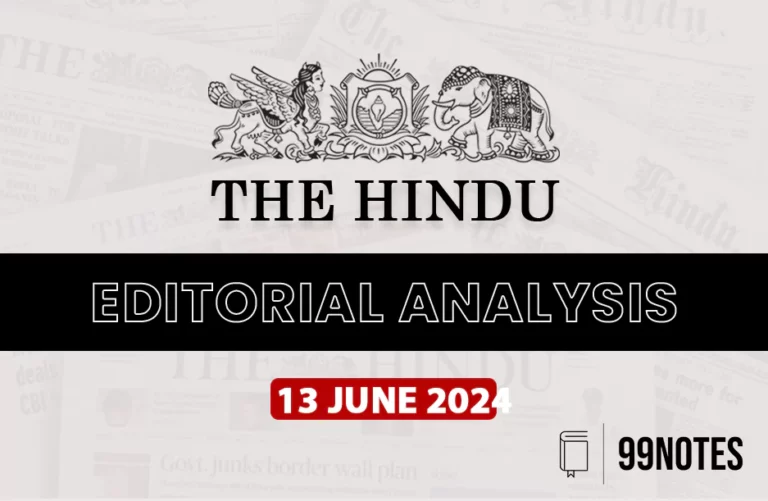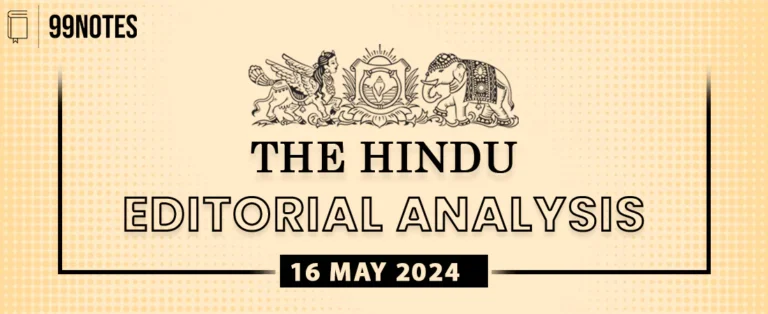24 April 2024 : The Hindu Editorial Notes PDF
The Hindu EDITORIAL
24-April-2024
1. Toss out the junk food, bring back the healthy food plate
|
Topic: GS2 – Social Justice – Health This topic is crucial for UPSC as it addresses public health, policy implementation, and socioeconomic implications relevant to governance. |
| Context: |
| ● The article highlights India’s nutritional transition towards unhealthy diets, emphasising policy interventions to combat rising junk food consumption and promote healthier lifestyles. |
Nutrition Transition in India:
- Shift in Dietary Patterns: India is undergoing a significant nutrition transition marked by a shift from traditional, fiber-rich diets to processed, high-calorie Western-style diets, coinciding with economic progress and urbanisation.
- Rise of Junk Food Consumption: Rapid economic growth and urbanisation have led to increased consumption of packaged and processed foods, termed “junk foods,” which are low in nutrients but high in calories, fats, salt, and sugar.
- Health Implications: Scientific evidence links junk food consumption to weakened immune systems, hypertension, diabetes, obesity, and increased cancer risk, contributing to the rise of lifestyle diseases in India.
Government Initiatives and Concerns:
- Supreme Court Ruling: The Supreme Court of India emphasised the right to life under Article 21 of the Constitution concerning public health hazards posed by unsafe food.
- Government Initiatives: Government initiatives like Eat Right India, the Fit India Movement, and Poshan 2.0 prioritise promoting healthy foods and active lifestyles.
- Regulatory Measures: FSSAI regulations restrict the sale of High in Fats, Salts, and Sugars (HFSS) foods in school environments.
- Concerns: Despite policy intentions, effective implementation remains a challenge, necessitating further action.
Strategies for Change:
Clear Definition of HFSS Foods:
- Define HFSS foods to enable better implementation of food safety regulations, focusing on protecting children from harmful impacts.
- Strengthen compliance through stricter enforcement by institutions like the National Commission for Protection of Child Rights.
Front-of-Pack Labelling (FOPL):
- Implement FOPL, such as warning labels indicating high salt content, to facilitate informed consumer choices.
- Introduce Indian Nutrition Rating (INR) based on nutritional profiles to guide consumers, addressing concerns of potential loopholes and voluntary compliance.
Subsidies for Healthy Foods:
- Develop policies offering subsidies for healthy foods like whole foods, millets, fruits, and vegetables to improve availability and affordability.
- Address the challenge of making nutritious foods more economically competitive than unhealthy alternatives.
Behavioural Change Campaigns:
- Launch multimedia campaigns targeting children and young adults to promote healthy dietary habits.
- Utilise initiatives like “vocal for local” to endorse local and seasonal produce and traditional foods, alongside educational efforts on balanced diets.
- Engage social media influencers to mainstream discussions about the health risks of junk foods and promote mindful eating practices.
Call to Action:
- Acknowledge the urgency of transitioning to healthier diets and fostering public demand for nutritious foods.
- Embrace a “Jan Andolan” or people’s movement for healthy and diverse diets, accompanied by sincere policy interventions to empower informed food choices.
Conclusion:
- Addressing the challenges posed by unhealthy dietary habits in India requires a multifaceted approach encompassing regulatory measures, consumer awareness campaigns, and policy interventions to promote access to and consumption of nutritious foods.
| Other measures that can be taken to curb junk food consumption |
|
● Public Awareness Campaigns: Launch nationwide campaigns highlighting the health risks associated with excessive junk food consumption, targeting both adults and children. ● Nutrition Education in Schools: Integrate comprehensive nutrition education into school curricula to instil healthy eating habits from a young age. ● Taxation Policies: Implement taxes on high-calorie, low-nutrient foods to discourage consumption and generate revenue for health initiatives. ● Advertising Restrictions: Enforce regulations limiting the marketing and advertising of junk food, especially targeting children through media channels. ● Promotion of Healthy Alternatives: Encourage the availability and affordability of nutritious alternatives in schools, workplaces, and public spaces. ● Menu Labelling Requirements: Mandate clear nutritional information on menus and packaging to enable informed consumer choices. ● Community Engagement Programs: Establish community-driven initiatives promoting local, sustainable, and healthy food options. ● Support for Local Farmers: Provide incentives and support for local farmers to produce and distribute fresh, healthy produce, reducing reliance on processed foods. ● Collaboration with the Food Industry: Collaborate with food manufacturers to reformulate products to reduce harmful ingredients and improve nutritional quality. ● Incentives for Healthy Eating: Introduce subsidies or incentives for individuals and families purchasing and consuming nutritious foods, making them more economically accessible. |
| PYQ: How far do you agree with the view that the focus on lack or availability of food as the main cause of hunger takes the attention away from ineffective human development policies in India? (250 words/15m) (UPSC CSE (M) GS-2 2018) |
| Practice Question: Discuss the challenges posed by the nutritional transition in India towards unhealthy diets and the role of policy interventions in promoting healthier lifestyles. (250 Words /15 marks) |
2. Towards a less poor and more equal country
|
Topic: GS3 – Indian Economy – Inclusive growth GS2 – Social Justice – Issues relating to poverty and hunger This topic is crucial for UPSC as it addresses socio-economic disparities and policy implications relevant to governance and development. |
| Context: |
| ● The article highlights the concerning rise of income and wealth inequality in India, exacerbated by economic reforms and posing challenges to inclusive growth. |
Income and Wealth Inequality:
- Current Scenario: In 2022-23, the top 1% of India’s population received 22.6% of the national income, while the top 0.1% earned nearly 10%. The wealth share of the top 1% was 40.1%, the highest since 1961.
- Trends: Wealth concentration increased threefold between 1961 and 2023. The rich grew richer, while the wealth share of the bottom 50% and middle 40% declined.
- International Comparison: India’s wealth inequality is less extreme than Brazil and South Africa, but its income inequality surpasses these countries, leading to heightened wealth disparity.
Impact of Economic Reforms:
- Effect of Liberalisation: Inequality began increasing after liberalisation in the 1980s, accelerating post the 1991 economic reforms.
- Comparison with British Raj: The rise of top-end inequality in India’s ‘Billionaire Raj’ now surpasses the disparity during the British Raj, undermining growth and poverty reduction efforts.
Relationship with Economic Growth:
- Historical Growth Patterns: India’s growth lags behind China and Vietnam since the 1970s, with a significant disparity emerging post-2000.
- Growth and Inequality: India’s growth is coupled with extreme economic inequality, unlike China’s more broad-based growth, making India both poor and unequal.
Importance of Human Development:
- State-Level Disparities: States with high growth rates also exhibit advanced human development, while economically backward states struggle to achieve significant growth.
- Global Ranking: India ranks lower in human development compared to neighbouring countries like Sri Lanka, Bhutan, and Bangladesh, despite being the fifth-largest economy.
- Inclusive Growth: Human development should precede economic growth to ensure inclusive development, as economic growth alone cannot address inequality.
Policy Recommendations:
- Priority to Human Development: Inclusive growth requires prioritising human development over solely economic objectives.
- Social Safety Nets: Existing schemes like the Pradhan Mantri Garib Kalyan Anna Yojana are insufficient to address deep-rooted inequality and poverty.
- Job Creation: Sustainable and inclusive growth necessitates job creation alongside welfare measures.
- Socio-Political Stability: Prolonged inequality levels risk social and political unrest, highlighting the urgency for comprehensive policy interventions.
Conclusion:
- India’s challenge lies in addressing deep-seated income and wealth inequality, which undermines its growth potential and exacerbates social disparities.
- Prioritizing human development and inclusive policies are imperative to achieve sustainable and equitable economic progress.
| Practice Question: Discuss the implications of rising income and wealth inequality in India for inclusive growth and suggest policy measures to address the issue. (150 Words /10 marks) |
3. While broadening eligibility, health insurance must be made affordable
|
Topic: GS2 – Social Justice – Health Critical for UPSC as it pertains to healthcare, demographic changes, and insurance regulation, reflecting broader socio-economic concerns in India. |
| Context: |
| ● The article discusses IRDAI’s directive for insurance companies to provide health insurance to senior citizens, addressing demographic changes and challenges in India. |
Additional information on this news:
- IRDAI directs insurance companies to provide health insurance to senior citizens above 65, acknowledging demographic changes in India.
- India’s population growth suggests a significant increase in the senior citizen cohort, projected to reach 30% by 2050.
- Many economically developed countries already face challenges in providing healthcare, affordable medicine, and caregiving infrastructure for seniors.
- Health insurance policies in such countries become exponentially more expensive with age, creating barriers to access for many.
- In India, only a small percentage of the economic elite can afford comprehensive family floater plans, leaving many without adequate coverage.
- IRDAI’s directive may result in more unaffordable health insurance policies without addressing underlying issues of affordability and accessibility.
- India’s future depends on leveraging its demographic dividend, but this also requires addressing the breakdown of traditional caregiving structures for the aged.
- Broadening health insurance eligibility should be accompanied by substantial improvements in affordable healthcare infrastructure.
| Significance of Health Insurance |
|
Significance: ● Financial Protection: Health insurance provides financial protection against unexpected medical expenses, ensuring individuals and families have access to healthcare services without facing financial hardship. ● Healthcare Access: Health insurance improves access to quality healthcare by enabling individuals to afford medical treatment, consultations, diagnostic tests, and medications. ● Preventive Care: Health insurance encourages preventive care and early detection of diseases through regular health check-ups, screenings, and vaccinations, promoting overall health and well-being. ● Reduced Out-of-Pocket Expenses: Health insurance reduces out-of-pocket expenses for healthcare services, relieving the burden on individuals and households, especially during medical emergencies or hospitalizations. Challenges: ● Affordability: High premiums, deductibles, and copayments make health insurance unaffordable for many individuals, particularly those with low incomes or in rural areas. ● Lack of Awareness: Limited awareness about the benefits of health insurance, complex insurance policies, and eligibility criteria hinder uptake and penetration of health insurance. ● Inadequate Coverage: Insufficient coverage, exclusions, and limitations in health insurance policies may leave policyholders underinsured, unable to access essential healthcare services or treatments. ● Healthcare Infrastructure: Inadequate healthcare infrastructure, including hospitals, clinics, and medical facilities, affects the quality and availability of healthcare services covered by health insurance. ● Fraud and Abuse: Health insurance fraud, abuse, and unethical practices by healthcare providers, insurers, and policyholders undermine the integrity and sustainability of health insurance schemes. Way Forward: ● Universal Health Coverage: Expand health insurance coverage to achieve universal health coverage, ensuring all individuals have access to essential healthcare services. ● Affordable Premiums: Make health insurance more affordable by reducing premiums, introducing subsidies, and offering financial assistance to low-income individuals and vulnerable populations. ● Public Awareness Campaigns: Launch public awareness campaigns to educate individuals about the importance of health insurance, benefits of coverage, and how to choose suitable insurance plans. ● Regulatory Reforms: Implement regulatory reforms to enhance transparency, accountability, and consumer protection in the health insurance sector, including standardising insurance products and regulating premiums. ● Technology Integration: Leverage technology and digital platforms to streamline health insurance processes, improve access to information, and enhance customer experience for policyholders. ● Partnerships and Collaboration: Foster partnerships between government, insurers, healthcare providers, and community organisations to strengthen health insurance schemes, expand coverage, and improve healthcare delivery. |
| Practice Question: Discuss the implications of IRDAI’s directive to insurance companies to provide health insurance to senior citizens, considering demographic shifts and healthcare challenges in India. (250 Words /15 marks) |
For Enquiry

24 April 2024 : The Hindu Editorial Notes PDF

24 April 2024 : PIB Summary for UPSC

24 April 2024 : Indian Express Editorial Analysis

Police Inspector Salary in India 2024

23 April 2024 : Daily Current Affairs Quiz

23 April 2024 : Daily Answer Writing

23 April 2024 : Daily Current Affairs

23 April 2024 : PIB Summary for UPSC

23 April 2024 : The Hindu Editorial Notes PDF

23 April 2024 : Indian Express Editorial Analysis
April 2024 The Hindu Editorial 24 April 2024 : The Hindu Editorial Notes PDF The Hindu EDITORIAL
23-April-2024
1. Restoring earth’s right to ‘good health’
Topic: GS1 – Geography…
April 2024 PIB 24 April 2024 : PIB Summary for UPSC PIB Summary for UPSC
24-April-2024
1. New NCPOR study attempts to resolve the Mystery of extremely low…
April 2024 Indian Express 24 April 2024 : Indian Express Editorial Analysis Indian Express Editorial Analysis
24-April-2024
1. Time to Heal
Topic: GS3 – Internal Security –…
Uncategorized Police Inspector Salary in India 2024 Police Inspector Salary: The starting salary of a police inspector in India is between 56,100 to 1,77,500…
Daily Quiz 23 April 2024 : Daily Current Affairs Quiz 23- April 2024 : Daily Quiz…
mains answer writing 23 April 2024 : Daily Answer Writing Mains Answer Writing
23-April-2024
Q1) Analysing various issues associated with farm subsidies, suggest…
April 2024 Daily Current Affairs 23 April 2024 : Daily Current Affairs Daily Current Affairs
23-April -2024- Top News of the Day3
1. ‘No data available on President returning…
April 2024 PIB 23 April 2024 : PIB Summary for UPSC PIB Summary for UPSC
23-April-2024
1. PRESIDENT OF INDIA PRESENTS PADMA AWARDS 2024
Topic: GS2 – Governance
The…
April 2024 The Hindu Editorial 23 April 2024 : The Hindu Editorial Notes PDF The Hindu EDITORIAL
23-April-2024
1. Restoring earth’s right to ‘good health’
Topic: GS1 – Geography…
April 2024 Indian Express 23 April 2024 : Indian Express Editorial Analysis Indian Express Editorial Analysis
23-April-2024
1. The cost of health
Topic: GS2 – Governance – Government…







